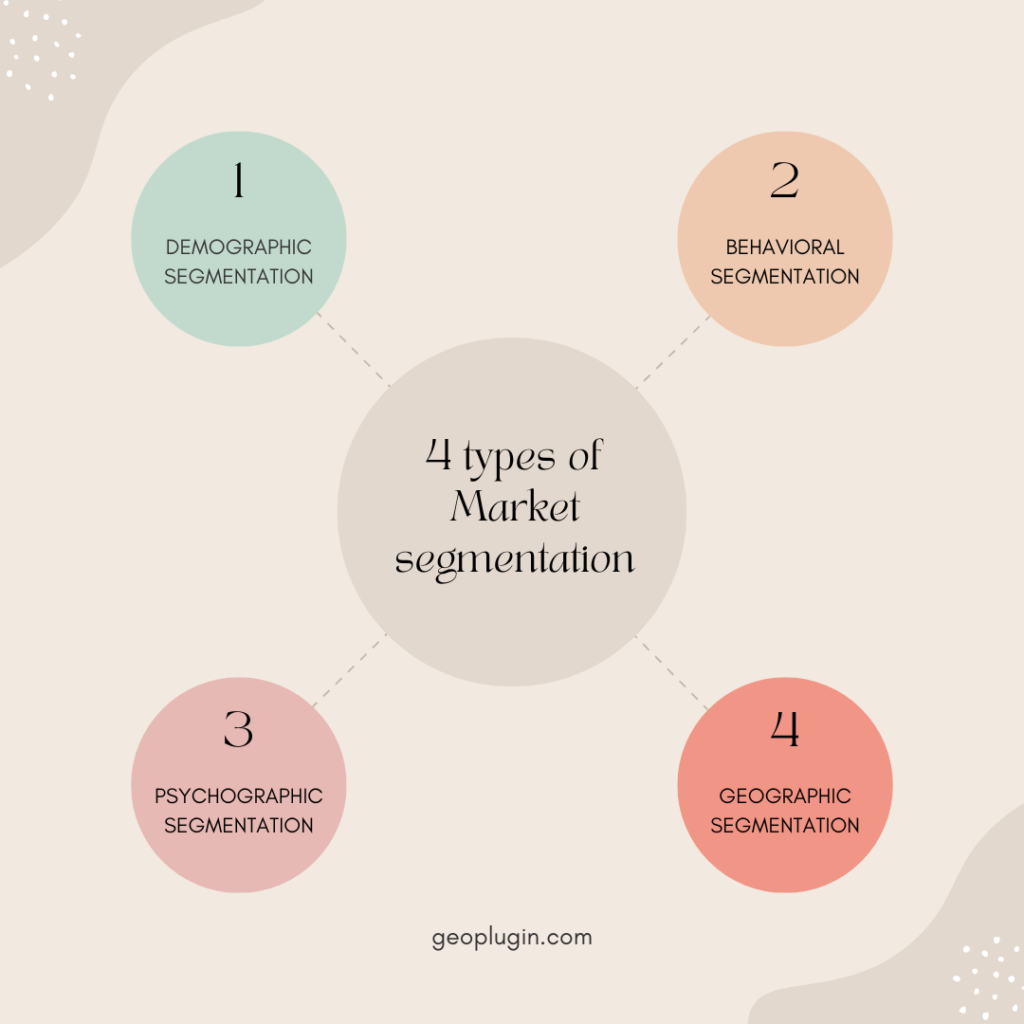Let’s say you’re a sports goods manufacturer that ships worldwide. However, despite your soccer shoes being the best in your product line, they don’t generate sales in certain regions. The absence of geographic segmentation from your marketing strategy could easily be the issue here.
The low sales might be due to the region’s preference for a different popular sport. By integrating geographic segmentation into your marketing strategy, you can target regions based on their preferences.
But what is geographic market segmentation, and how can you implement it in your business? Here’s a detailed guide covering everything about geographic segmentation.

Table of Contents
What Is Geographic Market Segmentation?
Geographic segmentation is a marketing technique that organizes audiences into distinct groups using location-based variables. These variables include geographic location factors like city, region, climate, or proximity to specific landmarks (more on this later).
By analyzing these patterns, businesses gain insights into the behavior, preferences, and buying decisions of their potential customers.
For instance, people in urban areas might have different purchasing habits than those in rural or suburban settings.
Moreover, companies selling weather gear can tailor their marketing based on climate conditions in different regions. Food chains also study regional preferences to adjust menus and promotions.
This knowledge helps marketers in decision-making, whether it’s about optimizing pay-per-click (PPC) ads or choosing billboard locations.
To segment target audiences, marketers use Geographic Information Systems (GIS) to visualize and analyze geographical data. This allows them to map customer information and identify hotspots.
5 Benefits of Geographic Segmentation
Here are the key benefits of geographically segmenting target audiences.

1. Targeted Marketing
Geographic segmentation allows businesses to tailor marketing campaigns to suit the specific needs and preferences of customers in different regions.
This enables businesses to optimize marketing strategies by concentrating resources on areas with the highest potential for success.

2. Improved Customer Engagement
By understanding the geographical context of their customers, businesses can create more engaging, personalized, and relevant marketing content. This boosts customer engagement and loyalty, as personalized marketing messages resonate more with target audiences’ local experiences and values.

3. Cost Efficiency
Reducing costs without reducing profits is the holy grail of running a business. Geographic market segmentation can help businesses allocate their marketing resources more smartly.
By focusing on specific geographic locations, businesses can avoid wasting resources on markets unlikely to yield positive results. This can lead to significant cost savings and improved return on investment.
4. Better Product Development
Geographic segmentation can provide valuable insights into the specific needs and preferences of customers in different regions.
These insights can help businesses create products that are a better fit for the needs of their target markets.
5. Competitive Advantage
Marketing campaigns that target specific geographic locations give businesses a competitive advantage over those using a more generic marketing approach.
Now, let’s see how marketers use geographic segmentation.

How Do Marketers Use Geographic Segmentation?
Geographically segmenting the market takes a lot of research and figuring out. Here’s how marketers use it:
1. Identify the Target Market
You see a problem and make a product/service to solve that problem, but who are you going to target? Marketers analyze the demographic, psychographic, and behavioral characteristics of consumers in a particular area to identify potential customers.
This allows them to focus their marketing efforts on areas with a high concentration of potential customers.

2. Tailor Marketing Messages
Marketers tailor their marketing messages based on the social and cultural preferences of consumers in different regions. This can include local languages, customs, traditions, and even weather conditions.
You would look silly targeting beachwear ads to consumers in snowy regions during winter.
The localized marketing messages increase the relevance of marketing campaigns and improve their chances of success.

3. Optimize Distribution Channels
Geographic market segmentation can also help marketers optimize their distribution channels.
By understanding the geographical spread of their target market, marketers ensure their products’ availability in areas where demand is high.
4. Conduct Proper Market Research
Segmenting the market by geography helps marketers understand the specific pain points and buying habits of consumers in different regions.
These insights can then inform product development, pricing strategies, and other key business decisions.
5. Plan Promotional Activities
Your business may sponsor a local event or run a location-specific ad campaign based on geographic segmentation insights.
Planning promotional activities with this approach increases brand visibility and engagement in key markets.
5 Variables Used in Geographic Segmentation
Here are some of the key variables businesses use for location-based segmentation:

1. Geographic Location
Geographic location refers to the physical location of the target audience, which can be as broad as a country or as specific as a neighborhood.
Marketers use this variable to adjust their marketing strategies to the unique characteristics of different locations. The location variable can be further broken down into the following sub-variables.
- Country: This is the broadest sub variable of location. Businesses use this when they want to market their products or services on a national scale. For example, a winter clothing brand might focus its marketing efforts on countries with colder climates, like Canada or Russia.
- City: Typically, businesses that offer goods or services only within a city use this sub-variable. For example, a local restaurant in New York City might use geographic segmentation to target potential customers of the city.
- Neighborhood: Businesses use this when they want to target a very specific local area. For instance, a local grocery store might use location segmentation to target potential customers living in its immediate vicinity.

2. Population Density
Population density refers to the number of people living in a specific area relative to its size. Different population densities demand different marketing strategies due to differences in lifestyle and preferences.
Based on population density, there are three key categories of regions.
- Urban areas: Urban areas have high population density, diverse demographics, and access to amenities. People in urban areas have a fast-paced lifestyle with a preference for convenience. When businesses target urban areas, their marketing strategy involves mobile apps, delivery services, and time-saving solutions.
- Suburban areas: Moderate population density, residential neighborhoods, and proximity to urban centers are basic characteristics of suburban areas. Populations in these areas are family-oriented, with space for large homes. For these reasons, businesses target them with family-friendly products along with home and garden items.
- Rural areas: Rural areas have low population density, open spaces, and agricultural landscapes. Rural populations tend to rely on local businesses as they are community-oriented. These people are also value-conscious when spending money. Therefore, businesses target them with affordable and durable goods.

3. Climate
The climate of a geographic location can significantly influence the needs and preferences of the local population.
For example, regions with consistently cold weather and snow, such as Northern Europe, require apparel like coats, boots, and scarves. There is also a high demand for heating systems, insulation, and warm bedding.
In contrast, hot regions with humidity and intense sunlight, such as the Middle East, have different consumer preferences. People in these areas favor lightweight, breathable fabrics like cotton and linen. They also prefer products offering sun protection, such as hats, sunglasses, and sunscreen.
Brands like North Face and Havaianas base their marketing efforts on climatic conditions.

4. Cultural Preferences
Cultural preferences refer to the unique tastes, values, traditions, and behaviors associated with specific cultural groups within a geographic region. Businesses have to consider cultural preferences because cultural norms, beliefs, and practices greatly influence consumer behavior.
In India, where vegetarianism is common due to cultural and religious reasons, fast-food chains like McDonald’s offer vegetarian menu items. Similarly, businesses operating in Muslim-majority countries adhere to halal certification for food products.
Businesses also have to be mindful of local languages and idiomatic expressions. Coca-Cola did this in the “Share a Coke” campaign, which personalized bottles with popular names in different languages.

5. Time Zone
Segmenting customers by time zone allows companies to send marketing messages at the most suitable times for each region. This way, businesses avoid inconvenience and enhance the relevance of their marketing messages.
E-commerce and retail online stores targeting U.S. and European customers adjust email campaigns to align with local waking hours. Sending promotional emails at the right time increases open rates and engagement.
How To Implement Geographic Segmentation
Geographic Segmentation may seem easy in theory, but implementing it is the real deal. Here’s how to implement it.
1. Gather Accurate Data
Data accuracy will make or break your segmentation. Gather accurate data on customer demographics, purchasing behavior, and geographic location. You can use sources such as customer databases, surveys, and location-based analytics.
You can use CRM systems, third-party data providers, and website analytics to ensure your data is up-to-date and comprehensive. This will help identify where your potential customers are within each geographic segment.
2. Choose Appropriate Variables
Next, choose appropriate variables relevant to your products or services. Determine whether your products will best suit a specific culture or are most useful in certain climates.
Also, consider other factors such as population density, time zone, and economic conditions.
3. Analyze and Segment
Now, use the chosen variables to group customers into meaningful segments. Analyze patterns, behaviors, and preferences within each segment. Understand how geographic context influences buying decisions.
4. Develop Targeted Campaigns
After segmentation, develop tailored marketing campaigns. Create region-specific marketing messages and content that resonate with your target audiences.
Translate materials into local languages and address region-specific pain points and cultural nuances for relevance and engagement.
5. Monitor and Adapt
Lastly, monitor and adapt your strategies. Track the performance of your marketing efforts by analyzing key metrics such as sales, customer engagement, and conversion rates.
Use this data to refine and optimize future marketing campaigns.
Let’s now take a look at a successful real-world example of geographic segmentation by the brand John Deere.

Successful Use of Geographic Market Segmentation by John Deere
John Deere is renowned for a wide range of products, including tractors, combine harvesters, sprayers, and planting equipment for agriculture. Each of its product categories caters to various climates, terrains, and agricultural practices prevalent in different regions.
In North America, John Deere promotes large, high-powered tractors and combines for expansive fields and high-yield crop farming. In contrast, in parts of Africa and Asia, John Deere emphasizes smaller, more affordable machinery. These products cater to small-scale farmers with diverse crop types and farming practices.
The company also adapts its marketing messages to reflect the local language and cultural nuances. This localization effort includes translating materials into local languages and showcasing testimonials from local farmers.
The company also highlights features that address region-specific challenges, such as water-efficient irrigation systems in drought-prone areas.
John Deere’s geographic segmentation strategy has been highly successful. In 2023 alone, the company’s production and precision agriculture segment generated a revenue of $26.8 billion.

Other Methods of Market Segmentation
Geographic segmentation isn’t the only method of dividing the market into groups. Here are some other common methods of market segmentation.

Demographic Segmentation
This method divides the market based on demographic factors such as age, gender, income, education, occupation, family size, and ethnicity.
For example, a luxury brand might target high-income individuals, while a toy company might focus on families with young children.
It’s also possible that your brand may target different demographics. For example, Samsung makes smartphones for all income groups. They have flagship phones costing $1200 and above, but they also sell affordable options that cost around $400.
Demographic Segmentation is a common segmentation method because demographic variables are easy to identify and measure.

Psychographic Segmentation
This method groups consumers based on psychological traits, lifestyle, values, attitudes, interests, and activities.
Psychographic segmentation offers deeper insights and can lead to more personalized and emotionally resonant marketing strategies.
Businesses typically use psychographic segmentation to target specific lifestyle choices and differentiate in competitive markets.
Behavioral Segmentation
Behavioral segmentation focuses on consumers’ behavior toward products, including purchasing habits, loyalty, usage frequency, and brand interactions. An e-commerce site offering personalized recommendations based on past browsing and buying behavior uses behavioral segmentation.
FAQ
Is geographic segmentation good?
Yes, geographic segmentation is effective as it tailors marketing messages to the specific needs and preferences of different regions. This increases the relevance of campaigns and improves their chances of success.
Consumers get relevant products, and companies sell products—a win-win for everybody.
What companies use geographic segmentation?
Usually, companies in retail, fast food, and beverages use geographic segmentation. For example, companies like McDonald’s, Coca-Cola, and Starbucks, use it to tailor products and marketing strategies to local preferences.
Segment Your Target Audience With geoPlugin
For effective geographic segmentation, you need authentic customer data. You need to research their buying habits, preferences, styles, and, most importantly, where they reside.
You may need to know their country, city, or even the town/street they are from. But the question is, how can you get your hands on the location data?
The answer is geoPlugin! geoPlugin provides you with geolocation data that you can use to segment your audience. The best part is that geoPlugin is free, so you can test it without spending a penny.
Sign up for free today and begin geographically segmenting your audience!













